The Museum Collections
Introduction
I. History and Art Collection
1. Icons of the 14th – 19th centuries
icons of the 14th – 17th century
2. Jewelry art of the 14th – 20th century
jewelry art of the 14th – 17th century
jewelry art of the 18th – 19th century
the european silver 14th - 19th centuries
3. Small-size sculptures (works of metal, wood, bone)
XI – the beginning of the XX century
Small-size sculptures 11th – 17th century
Small-size sculptures 18th – early 20th century
enamel of Troitza masters 15-8th – early 20th century
5.Embroidery, lace, textiles of the 14th - early 20th century
icon and ornamental embroidery
gold and silver lace
6.Painting of the 18th – 21st centuries
painting of the 18th – 19th centuris
painting of the 20th – 21st centuris
II.Manuscripts and old printed books of the 14th – 17th century
IV.Lithography of the 18th – 19th century
V.Numismatics
VI.Medals of the 18th - early 20th century
VIII.Archeology collection
IX. Russian folk and applied and decorative art of the 17th – 21st c.
1. Artistic wood
folk carved and painted wood
wooden toys
house carving of Sergiev Posad
Khokhloma and Gorodets painting
2. Artistic textiles
embroidery and weaving
printed textiles and lace
Russian shawls
folk costumes
folk garments
printed cotton kerchiefs
|
Russian printed cotton kerchiefs of 19th - the beginnings 20th centuries(p. 1)
|
The collection of printed cotton kerchiefs of the end 19th - the beginnings of 20th centuries in Sergiev-Posad museum belongs to number of the fullest in Russia. It totals more than 300 items, providing notion about activity and art possibilities of the leading centres of cotton-printing manufacture of Moscow and Vladimir province. Kerchiefs with the printing brands have special value; they allow establishes the place and sometimes the times of their manufacturing. These are products of the Moscow factories of A.Gyubner, P.Kotov, associations of the ‘Trehgorhaya” and Danilovsky manufactories belonging to Baranov, Posylin, Rubachev and other family.
Printed cotton business in Russia began got implanted since 2nd half of 18th century in connection with development of the textile industry. The largest institutions were constructed in the Vladimir, Moscow and Petersburg provinces. Textiles were made manually: the drawing printed on Indian or English calico with wooden boards - "maners". Russian chintz and kerchiefs not only had invariable success in the country, but also received numerous prizes and awards at the international exhibitions, where their founders received special differences.
Îne of the largest factories of the end 19th - the beginnings of 20 centuries was the “Trehgornaya” (Three-mountain) manufactory based in 1799 by V.I. Prokhorov and F.I.Rezanov. Among various assortment of the Prohorov’s manufactory the important place was occupied with kerchiefs and shawls. Their manufacturing from the moment of the basis of manufacture and prior to the beginning of 20th century was mainly manual. On the majority of products, as a rule, "classical" placing of an ornament: wide, with a magnificent flower garland a border, big central part with rhythm counterbalanced bouquets or branches creating sensation of some static character of the pattern.
Products of a pre-revolutionary “Trehgornaya” (Three-mountain) manufactory differed high art taste. The harmonious and counterbalanced parity of forms and rhythms of a flower ornament, absence of diversity and clamorousness in its colouring were characteristic for them.
|
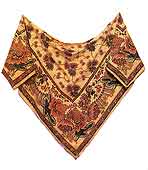
Kerchief.. Before 1874. Moscow. Prohorov’s “Trehgornaya” (Three-mountain manufactory) |
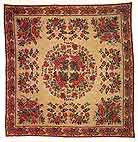
Kerchief.. Early of 19th - late of 20th centuries. Moscow. Association of the “Trehgornaya” (Three-mountain manufactory) |

Shawl. 1854. Moscow. Prohorov’s factory |
The most extensive group of 140 items makes up kerchiefs of the Baranov’s Troitsko-Aleksandrovskaya manufactory, which were in Karabanovo village of Aleksandrov district of the Vladimir province. It conducts the history since 1846 when I.F. Baranov has constructed factory on which was made dyeing of red calico, stuffing of kerchiefs and manufacturing shirt calico, painted in red "Adrianople" colour.
Polichromatic vegetative patterns took the basic place in ornamentation products of the Troitsko-Aleksandrov manufactory. They are extremely generalized, conditional and solved graphically planar. Red colour, being present at each element of a pattern, united middle part and a border, a background and an ornament. Geometrical and oriental ("cucumber") motives there are on Baranov’s kerchiefs equally with vegetative patterns.
Patterns, characteristic for national stuffed fabrics of 19th century remained as a whole, on Baranov’s red calico kerchiefs. Both at manual, and at the advanced, mechanical printing they continued to be used up to 1920th.
|
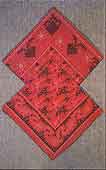
Kerchiefs. Early of 19th – late of 20th centuries. Vladimir province, Aleksandrov district, Karabanovo village. Association of manufactories of Baranov |
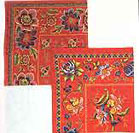
Fragments of kerchiefs. Early of 19th – late of 20th centuries. Vladimir province, Aleksandrov district , Strunino village. Association of the Sokolovky manufactory of A.Baranov |
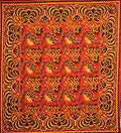
Kerchief. Early of 19th – late of 20th centuries. Vladimir province, Aleksandrov district, Karabanovo village. Association of manufactories of Baranov |
Shuya where from the end of 18th century there was the weave-printed fabric belonging to merchants Posylins was one more known centre on manufacturing of cotton kerchiefs. In 1841 there was a division of property of Posylins family that has led to foundation of two independent manufactures: one of Posylin Stepan Ivanovich and other – of Posylin Alexey Ivanovich. Though on a manufactory of Posylins for the first time has appeared pirrotina, but the manual heel-tap of kerchiefs remains in both fabrics to 1920s.
In the museum stored collection of Posylin’s kerchiefs of 37 items executed in the manual way. They are characterised, first of all, by a variety of colour and composite decisions.
|
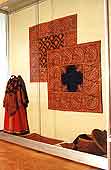
Kerchiefs. Early of 19th – late of 20th centuries. Vladimir province. Shuya. Association of a manufactory of S. Posylin |
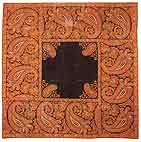
Kerchief. Early of 19th – late of 20th centuries. Vladimir province. Shuya. A.Posylin's factory |
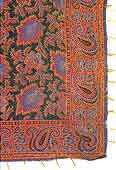
Kerchief. Early of 19th – late of 20th centuries. Vladimir province. Shuya. S.Posylin's manufactory |
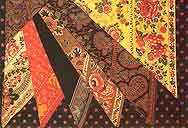
Fragment of the exhibition of Russian print kerchiefs of 19th – early 20th centuries. 1994 |
|


